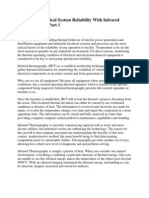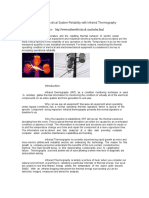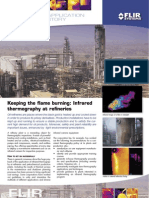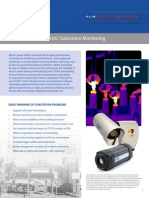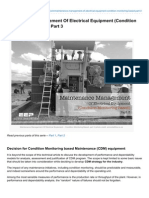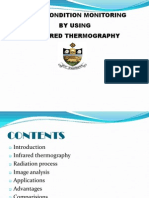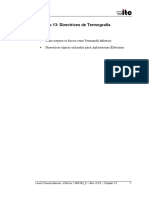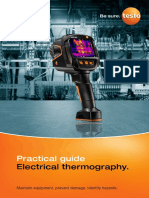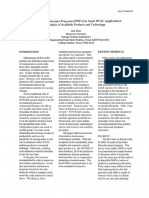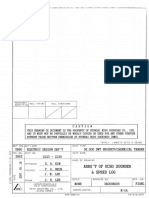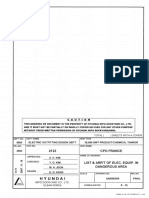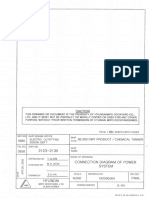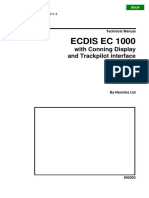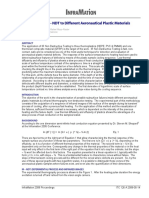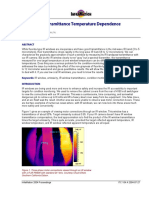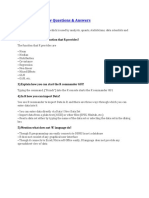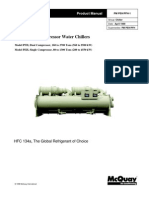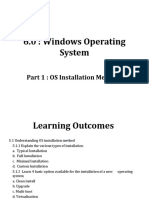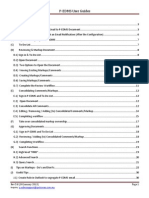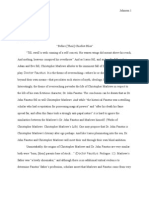2008-043 Leonard
2008-043 Leonard
Uploaded by
alexanderCopyright:
Available Formats
2008-043 Leonard
2008-043 Leonard
Uploaded by
alexanderCopyright
Available Formats
Share this document
Did you find this document useful?
Is this content inappropriate?
Copyright:
Available Formats
2008-043 Leonard
2008-043 Leonard
Uploaded by
alexanderCopyright:
Available Formats
Scheduling and Planning—Key Ingredients for Successful IR Surveys
(If you fail to plan—plan to fail)
Ken Leonard
Progress Energy, Raleigh, North Carolina
Robert Madding
Infrared Training Center, FLIR Systems, Inc.
ABSTRACT
Using a standard schedule for IR surveys has been identified as a best practice among infrared
thermographers. For electric power distribution equipment, this schedule should begin with the put-in-service
date for new equipment. Reasons for a baseline IR survey on new equipment are to ensure safety, proper
installation, identification of manufacturer defects and to ensure continuity of service for customer. Following
the initial IR survey it is recommended to repeat the IR survey in one year. Upon completion of the one year
IR survey, a three year rotation schedule should be followed. In addition to the standard schedule for IR
surveys attention needs to be placed on the planning of the timing of completing the IR surveys. By
recognizing the importance of standard scheduling and planning IR surveys, thermographers can contribute
value to their industry. This paper will address benefits and reasons for a standard schedule as well as
proper planning of IR surveys on electric power distribution equipment.
INTRODUCTION
The value of infrared thermography as a predictive maintenance (PdM) tool is well established. However, the
frequency of IR surveys and standard scheduling are often overlooked as a standard operating procedure.
Infrared thermographers often perform tasks in addition to their thermography role and these tasks often deal
with emergency situations such as ice storms, electrical storms, and unforeseen equipment breakdown and
so on. With IR survey frequency being long term and viewed as flexible, crises often preclude performing a
standard IR survey. The danger here is postponing an IR survey can lead to equipment problems creating a
crisis that further postpones the IR survey. This results in a breakdown of the IR survey routine and the IR
program is seen as ineffective. Having a standard schedule helps prevent this situation, allowing some
flexibility for unavoidable emergencies, while keeping IR thermography as an effective tool in preventing
avoidable equipment failures.
SCHEDULING CONSIDERATIONS FOR IR SURVEYS
Keeping IR thermography as an effective PdM tool for preventing electric power distribution equipment failure
that can be catastrophic significantly improves company personnel and customer safety, operational reliability
and maintenance cost optimization. IR thermography can only be an effective tool when used in a well-
defined program that includes IR survey scheduling and appropriate IR survey frequency.
Safety is of utmost concern for all industries. A standard schedule for IR surveys assures employees the fact
a line has been patrolled and all equipment presents itself in safe working conditions. Secondly, if a problem
is identified by a standard scheduled IR survey this allows for the employee to be pre-warned of a potential
hazard. Thirdly, the thermographer uses the IR camera as a safety tool. When entering a substation after a
tailboard safety meeting, the thermographer immediately does a quick IR survey of the entire substation
looking for any major problems. If none are found, the routine survey commences. If one or two are found
they’re documented and called in immediately. Appropriate safety action is taken including leaving the area.
Communication plays a key role in any PdM program. In fact many believe communication represents 70% to
80% of the effort of any good PdM program. The thermographer has as a part of his/her standard scheduling,
report generation that documents the problems found with their severity level and potential hazard. Report
routing is an important facet to this, so all relevant personnel are aware of the situation. You can only repair
problems you are aware of.
Figure 1 shows a 200 amp terminator connector with a significant problem in a PMH cabinet. This feeds the
Progress Energy distribution control center facility. Failure of this connection would force the facility to an
InfraMation 2008 Proceedings ITC 126 A 2008-05-14
alternate backup feed and possibly force a transfer to backup generators. With all systems functioning
properly, the backup would be a seamless transition for all data and control systems, but all air conditioning
and some other systems would go out for a short period of time. Should this component fail catastrophically it
could destroy the entire PMH cabinet circuitry. Cost of catastrophic failure would cost at least 10 times more
to repair than fixing the problem as found. It also increases control center risk as now they would be relying
on a backup system for several hours instead of a few minutes.
Figure 1. 200 Amp terminator connector showing a significant problem in a PMH cabinet feeding a
Progress Energy Facility.
What actually happened was Ken called the problem in immediately to the area distribution field supervisor
and followed up with a written IR report for documentation. The problem was fixed the same day it was
found.
The initial IR survey performed on installation of new equipment and cabling provides opportunities to identify
improper installation. Figures 2 and 3 give visual and IR images of an in-service startup IR survey. New
cables were pulled and two of the three terminators were improperly installed resulting in abnormal thermal
patterns as shown in Figures 2 and 3.
This identification contributes to continuity of service and customer satisfaction. This IR survey can also
identify training needs for certain skill set employees to prevent improper installation in the future.
Figure 2. 750 kcmil terminator above left showing improper installation resulting in heating. The right
terminator above is installed correctly is not showing heat.
Trending of problems is another technique for watching minor problems and fixing them before they become
major problems. Trending also provides data for determining IR survey frequency. Timing is important. Too
frequent and you’re wasting resources. Not frequently enough and you’re going to have equipment failures.
InfraMation 2008 Proceedings ITC 126 A 2008-05-14
Figure 3. Another example of 750 kcmil terminators. The left terminator is proper installation resulting
in no heating. The right terminator is an example of improper installation resulting in heating.
TIMING CONSIDERATIONS FOR PLANNING IR SURVEYS
Put the thermographer with his/her IR camera in front of the equipment and do the IR survey. That’s it, right?
Not so fast. For electrical IR work, the preponderance of which is distribution equipment for Ken, there are
other factors to consider. Electrical systems don’t get hot when there’s no electrical load (current) and the
load in distribution systems is very customer and weather dependent. For North Carolina air conditioning is a
major load in summer with manufacturing and commercial uses adding to the load. The Raleigh and
surrounding area includes several large hospitals and other manufacturing which all demand high reliability of
electrical service.
Weather conditions will affect the integrity of IR surveys. Temperature, wind speed, humidity, and cloud cover
are all important considerations when planning your IR survey. Seasonal peak differences should be
considered when planning as well. For example the summer peak load is a different time than the winter
peak, 6:30 AM for winter and 4:30 PM for summer in the Raleigh area. But in terms of the weather, solar
loading has a severe impact on outdoor equipment and makes going at peak load times difficult in the
summertime unless the day has been cloudy. The latter can make mid-afternoon IR surveys optimal.
The time of day you begin your IR surveys can lead to some interesting findings. Ken’s day often begins at
3:30 AM. No solar loading, little wind and enough load to drive hot spots and on PMH cabinets there can be
significant condensation which have given Ken some “head-scratchin’” hot spots. Hot spots will appear on
terminators as shown in Figure 4 probably due to “tracking” or current leakage. When they dry out, the hot
spots disappear.
Figure 4. Moisture condensation induced “tracking” across a 750 kcmil terminator. Hot areas in IR image on right
indicate heating due to tracking. Concern of authors is this could eventually result in a flashover.
InfraMation 2008 Proceedings ITC 126 A 2008-05-14
Can these areas eventually flashover? Or, is this a weather related anomaly that has no overall impact on the
equipment? We just don’t know at this time.
Customer events present a strong consideration for planning your IR surveys. Access to secure facilities
often requires several days notice and strong documentation. Normal working hours are preferred to facilitate
the escort and ensure inspection of key areas.
Figure 5 shows a severely overheated fuse cutout running at 260 °F. This feeds a pharmaceutical
manufacturing facility that runs 24 hours per day 7 days per week. An outage would severely impact their
process and could result in significant revenue loss. This particular facility does not have backup generation.
It is stub fed, not loop fed meaning the fuse cutout is a single point of failure for them. There’s no automatic
way to get power to their facility. During normal working hours they could be down for 2 hours, double that
after normal working hours.
HOT: 260°F
REF.: 83°F
Figure 5. Fuse cutout showing severe thermal problem that if failed would generate an outage for a
pharmaceutical manufacturer that operates 24/7.
SUMMARY
Safety of both employees and customers is a primary consideration of all utilities and Progress Energy is no
exception. IR surveys enhance safety as personnel know ahead of time where the problems are and can
avoid encroachment until repairs are implemented.
To keep the electrical distribution system reliability high, Progress Energy relies on IR thermography as a key
PdM tool. To be effective there needs to be a plan and the plan needs to be followed. Progress Energy
schedules IR surveys on a routine basis, considers all the factors in the timing of the surveys and
communicates IR survey results to key personnel in a timely fashion. Their IR program has saved them
millions of dollars over the years in avoided maintenance costs. And customer satisfaction for reliable
delivery of service is high. Progress Energy management supports the IR program and they have been
rewarded with a successful effort.
InfraMation 2008 Proceedings ITC 126 A 2008-05-14
You might also like
- Speed Measuring Unit User Manual (ESP-2000-B)Document9 pagesSpeed Measuring Unit User Manual (ESP-2000-B)alexander100% (7)
- Advanced Temperature Measurement and Control, Second EditionFrom EverandAdvanced Temperature Measurement and Control, Second EditionNo ratings yet
- BFD-180-570 DN65 GBDocument25 pagesBFD-180-570 DN65 GBalexander100% (3)
- Analysis of Profile Map - PQWT Water DetectorDocument76 pagesAnalysis of Profile Map - PQWT Water DetectorFrancisco Hernán Berrios Valenzuela100% (1)
- Industrial Applications of Infrared Thermography: How Infrared Analysis Can be Used to Improve Equipment InspectionFrom EverandIndustrial Applications of Infrared Thermography: How Infrared Analysis Can be Used to Improve Equipment InspectionRating: 4.5 out of 5 stars4.5/5 (3)
- Improving Electrical System Reliability With Infrared ThermographyDocument5 pagesImproving Electrical System Reliability With Infrared ThermographyMohd Shawal50% (2)
- 2005 Chudnov Sky PaperDocument0 pages2005 Chudnov Sky PaperCharles_DNo ratings yet
- Gen4000 Service W455H (Wash Machine)Document100 pagesGen4000 Service W455H (Wash Machine)alexanderNo ratings yet
- SRF HRF SSR DanjouxDocument12 pagesSRF HRF SSR Danjouxalexander100% (1)
- Secrets of Bushing Oil Level-GoffDocument8 pagesSecrets of Bushing Oil Level-Goffalexander100% (1)
- Important Mesurements For IR Surveys in SubstationsDocument7 pagesImportant Mesurements For IR Surveys in SubstationsalexanderNo ratings yet
- Finding Oil Filled Circuit Breaker Resistance With IRDocument8 pagesFinding Oil Filled Circuit Breaker Resistance With IRalexanderNo ratings yet
- Electrical Thermal ImagingDocument6 pagesElectrical Thermal ImagingPillai Sreejith90% (10)
- Thermal Predictive Maintenance at A Coal PlantDocument3 pagesThermal Predictive Maintenance at A Coal PlantYugandhara Chakravarthy KancherlaNo ratings yet
- Thermographic Imaging InspectionsDocument3 pagesThermographic Imaging InspectionsAlamNo ratings yet
- Improving Electrical System Reliability With Infrared ThermographyDocument11 pagesImproving Electrical System Reliability With Infrared ThermographyLalit Prakash100% (1)
- Improving Electrical System Reliability With Infrared ThermographyDocument12 pagesImproving Electrical System Reliability With Infrared ThermographyAJITH A RNo ratings yet
- Thermal Imaging Technology For Predictive Maintenance of Electrical Installation in Manufacturing Plant-A Literature ReviewDocument6 pagesThermal Imaging Technology For Predictive Maintenance of Electrical Installation in Manufacturing Plant-A Literature ReviewadiNo ratings yet
- Applying Infrared ThermographyDocument4 pagesApplying Infrared ThermographyJaya DiNo ratings yet
- DataguidefieldDocument5 pagesDataguidefieldapi-307457129No ratings yet
- Cost of Applying I RDocument4 pagesCost of Applying I RMishkat Immaculate100% (1)
- Thermography in The Service Center - Nyberg - 0607Document42 pagesThermography in The Service Center - Nyberg - 0607andres monederoNo ratings yet
- LEM The Power of Prep EPM GuideDocument17 pagesLEM The Power of Prep EPM GuideAgus MulyanaNo ratings yet
- Infrared Inspection On Electrical Installations at HospitalsDocument3 pagesInfrared Inspection On Electrical Installations at Hospitalscantorband8234No ratings yet
- Inspect Electric9Document7 pagesInspect Electric9Anonymous Wu6FDjbNo ratings yet
- Infrared Thermography at RefineriesDocument2 pagesInfrared Thermography at Refineriesayviwurbayviwurb100% (1)
- Inspecting Electrical Systems Using Infrared ThermographyDocument2 pagesInspecting Electrical Systems Using Infrared ThermographyGustavNo ratings yet
- Improving Electrical System Reliability With Infrared ThermographyDocument12 pagesImproving Electrical System Reliability With Infrared Thermographysuraj559No ratings yet
- Fi ND Beforeaflare Up: HotspotsDocument2 pagesFi ND Beforeaflare Up: HotspotsGeorge Romero Tadeu Carvalho NunesNo ratings yet
- Thermal Predictive Maintenance at A Coal Plant: Testing FunctionsDocument3 pagesThermal Predictive Maintenance at A Coal Plant: Testing Functionseddie2166No ratings yet
- SubStation White PaperDocument4 pagesSubStation White Papersretend_618721007No ratings yet
- Predictive Maintenance in A Mission Critical EnvironmentDocument9 pagesPredictive Maintenance in A Mission Critical EnvironmentUrsula JohnsonNo ratings yet
- Wiring Matters Issue 74 March 2019Document14 pagesWiring Matters Issue 74 March 2019Thomas OrNo ratings yet
- Reduce Costs by Fixing Electrical and Motor Problems in Factories WHITEPAPERDocument13 pagesReduce Costs by Fixing Electrical and Motor Problems in Factories WHITEPAPERharigopalk12100% (1)
- Overhead Line Thermal Rating Calculation Based On Conductor Replica MethodDocument6 pagesOverhead Line Thermal Rating Calculation Based On Conductor Replica Methodalen123456No ratings yet
- 1910 DB 1208Document9 pages1910 DB 1208Nitin SoniNo ratings yet
- Maintenance Management of Electrical Equipment Condition Monitoring Based Part 3Document4 pagesMaintenance Management of Electrical Equipment Condition Monitoring Based Part 3at35No ratings yet
- Calculation of Optimum Preventive Maintenance Intervals For Electrical EquipmentDocument6 pagesCalculation of Optimum Preventive Maintenance Intervals For Electrical EquipmentJim Ha100% (1)
- Maintenance of SubstationDocument129 pagesMaintenance of Substationrama mohan100% (1)
- Case Study EMO 1Document3 pagesCase Study EMO 1Mark Joseph FalcesoNo ratings yet
- Why Is Thermography Testing of Electrical Panel Important?Document13 pagesWhy Is Thermography Testing of Electrical Panel Important?Itz AleshaGachaverse100% (1)
- Infrared Cameras Enhance Productivity and Safety at GM: Daniel Sinclair, General Motors Corporation Leonard PhillipsDocument6 pagesInfrared Cameras Enhance Productivity and Safety at GM: Daniel Sinclair, General Motors Corporation Leonard PhillipsJeman Man100% (1)
- MaintenanceDocument55 pagesMaintenanceAshraf EnjoyingNo ratings yet
- MaintenanceDocument34 pagesMaintenancerashm006ranjan100% (3)
- Solar Plant Monitoring NovemberDocument10 pagesSolar Plant Monitoring NovemberTaro AncutaNo ratings yet
- Plant Condition Monitoring by Using Infrared ThermographyDocument17 pagesPlant Condition Monitoring by Using Infrared ThermographyGoutham Reddy50% (2)
- Lafarge Thermography ProgramDocument17 pagesLafarge Thermography ProgramDiego AlejandroNo ratings yet
- 13 DirectricesDocument12 pages13 DirectricessorsanbarNo ratings yet
- Infrared Inspection DataDocument9 pagesInfrared Inspection DataAnonymous Wu6FDjb100% (1)
- Electric Substation MonitoringDocument4 pagesElectric Substation MonitoringayviwurbayviwurbNo ratings yet
- Inframation Paper How To Guarantee Failure As A Thermographer Ron LucierDocument7 pagesInframation Paper How To Guarantee Failure As A Thermographer Ron LucierAnonymous Wu6FDjbNo ratings yet
- Solar Plant Monitoring: A Standards-Based Approach To Evaluate and Improve PerformanceDocument7 pagesSolar Plant Monitoring: A Standards-Based Approach To Evaluate and Improve PerformanceVassilis NellasNo ratings yet
- Power Engineering PM Check ListDocument11 pagesPower Engineering PM Check ListSelvn SubramanianNo ratings yet
- ABB Corporate Research, Germany: N. L. FantanaDocument4 pagesABB Corporate Research, Germany: N. L. FantanaJose ValdiviesoNo ratings yet
- Electrical Maintenance Prioritization Where Do I StartDocument13 pagesElectrical Maintenance Prioritization Where Do I StartDDivyanshu SharmaNo ratings yet
- Infrared Thermal Imaging InspeDocument129 pagesInfrared Thermal Imaging InspeAnonymous Wu6FDjbNo ratings yet
- Electrical Preventive Maintenance and ChecklistDocument8 pagesElectrical Preventive Maintenance and ChecklistEdmund Yoong100% (6)
- Practical Guide: Electrical ThermographyDocument30 pagesPractical Guide: Electrical Thermographyinderhearth13No ratings yet
- Type of MaintenancDocument10 pagesType of MaintenancMohammed ShantiNo ratings yet
- Introduction To Thermographic Analysis SKFDocument14 pagesIntroduction To Thermographic Analysis SKFTeckelino100% (1)
- Predictive Maintenance Programs (PMP'S) in Small HVAC Applications: Analysis of Available Products and TechnologyDocument4 pagesPredictive Maintenance Programs (PMP'S) in Small HVAC Applications: Analysis of Available Products and TechnologyEdmund YoongNo ratings yet
- Power Generation: Coal-Fired: Bently Nevada Asset Condition MonitoringDocument12 pagesPower Generation: Coal-Fired: Bently Nevada Asset Condition MonitoringsirtrungNo ratings yet
- Infrared Thermography (Examples 2009-2) (互換モード)Document20 pagesInfrared Thermography (Examples 2009-2) (互換モード)MELgamiNo ratings yet
- How Advanced On-Line Partial Discharge Diagnostics Can MakeDocument12 pagesHow Advanced On-Line Partial Discharge Diagnostics Can MakeBucur Ilie100% (1)
- Practical, Made Easy Guide To Building, Office And Home Automation Systems - Part OneFrom EverandPractical, Made Easy Guide To Building, Office And Home Automation Systems - Part OneNo ratings yet
- Practical Control of Electric Machines: Model-Based Design and SimulationFrom EverandPractical Control of Electric Machines: Model-Based Design and SimulationNo ratings yet
- E-14 3A000E005 Arrt of Echo Sounder & Speed LogDocument21 pagesE-14 3A000E005 Arrt of Echo Sounder & Speed LogalexanderNo ratings yet
- E-06 1a000e006 WD of Navig and Communication SystemDocument58 pagesE-06 1a000e006 WD of Navig and Communication SystemalexanderNo ratings yet
- E-11 1a000e010 CD of Control & Instrument SysDocument111 pagesE-11 1a000e010 CD of Control & Instrument SysalexanderNo ratings yet
- E-15 3A000E009 List and Arrt of El Eqpmt in Dangerous AreaDocument200 pagesE-15 3A000E009 List and Arrt of El Eqpmt in Dangerous AreaalexanderNo ratings yet
- E-04 1a000e004 CD of Power SystemDocument90 pagesE-04 1a000e004 CD of Power SystemalexanderNo ratings yet
- DS 30Document148 pagesDS 30alexanderNo ratings yet
- IR Thermography For Wildlife Exposed To Oil-Reese-DeyoeDocument14 pagesIR Thermography For Wildlife Exposed To Oil-Reese-DeyoealexanderNo ratings yet
- Ecdis Ec 1000: With Conning DisplayDocument184 pagesEcdis Ec 1000: With Conning DisplayalexanderNo ratings yet
- EC1000 Conning&interfaceDocument198 pagesEC1000 Conning&interfacealexanderNo ratings yet
- IR NDT On Aeronautical Plastics-Flores-BolarinDocument8 pagesIR NDT On Aeronautical Plastics-Flores-BolarinalexanderNo ratings yet
- Gas Sampling System Consilium PDFDocument135 pagesGas Sampling System Consilium PDFalexander50% (2)
- NETA Severity CriteriaDocument1 pageNETA Severity CriteriaalexanderNo ratings yet
- Model Number StructureDocument12 pagesModel Number StructurealexanderNo ratings yet
- DSC 60Document132 pagesDSC 60alexanderNo ratings yet
- Using IR For Iso-Phase Bus Duct-TheyerlDocument6 pagesUsing IR For Iso-Phase Bus Duct-TheyerlalexanderNo ratings yet
- 2005-021 MotwaniDocument6 pages2005-021 Motwanialexander100% (1)
- Guess The Real World Emissivity-DeMonteDocument14 pagesGuess The Real World Emissivity-DeMontealexanderNo ratings yet
- 2008-026 DenioDocument8 pages2008-026 DenioalexanderNo ratings yet
- 2004-028 - Madding-IR Window TransmittanceDocument10 pages2004-028 - Madding-IR Window TransmittancealexanderNo ratings yet
- Emissivity and AccuracyDocument9 pagesEmissivity and Accuracyalexander100% (1)
- A EN Technical Publication 47 Insulation AlarmDocument4 pagesA EN Technical Publication 47 Insulation AlarmalexanderNo ratings yet
- 1 Unit 01 Aug Ai IntroductionDocument3 pages1 Unit 01 Aug Ai IntroductionPragati TripathiNo ratings yet
- 2 Common Logical FallaciesDocument16 pages2 Common Logical FallaciesMykhaela Alexa TordesillasNo ratings yet
- Anatomy of The Dromedarian CamelDocument127 pagesAnatomy of The Dromedarian CamelAnanda afu BwNo ratings yet
- Characteristics of LDCsDocument22 pagesCharacteristics of LDCstinsaeres100% (2)
- Ca510 Atlas CopcoDocument249 pagesCa510 Atlas CopcoBruno RibeiroNo ratings yet
- ANA SlideDocument15 pagesANA SlideMaisha RahmanNo ratings yet
- The Righteousness of GodDocument27 pagesThe Righteousness of GodemmanueloduorNo ratings yet
- Top 18 R Interview QuestionsDocument3 pagesTop 18 R Interview Questionsprince2venkatNo ratings yet
- Mquay ChilledDocument84 pagesMquay ChilledRidwan Pramudya100% (1)
- Breast CancerDocument37 pagesBreast CancerElaisa ColimaNo ratings yet
- Contoh CV Akademik S3Document2 pagesContoh CV Akademik S3Chrystian ChandraNo ratings yet
- Phys 3105Document9 pagesPhys 3105myo htetNo ratings yet
- Rehabilitation Versus Surgical Reconstruction For Non-Acute Anterior Cruciate Ligament InjuryDocument11 pagesRehabilitation Versus Surgical Reconstruction For Non-Acute Anterior Cruciate Ligament InjuryJesusNavarrete97No ratings yet
- TeachingDocument21 pagesTeachingRosdiyana Bahtika100% (1)
- Alcadipani Hassard 2010 Actor Network Theory Organizations and Critique Towards A Politics of OrganizingDocument18 pagesAlcadipani Hassard 2010 Actor Network Theory Organizations and Critique Towards A Politics of Organizingmariasandrarobles60No ratings yet
- Porter's Diamond Model Case Study1Document11 pagesPorter's Diamond Model Case Study1amitkpatNo ratings yet
- HO5 Business Combination at Acquisition DateDocument4 pagesHO5 Business Combination at Acquisition Dateitzadizazta01No ratings yet
- Unit 3Document29 pagesUnit 3Rashmin ParmarNo ratings yet
- Bangladesh Economic CrisisDocument92 pagesBangladesh Economic CrisisRafin সাজ্জাদNo ratings yet
- (Microsoft Word - UVS-300 - 245 - 277 - 255 - 261Document2 pages(Microsoft Word - UVS-300 - 245 - 277 - 255 - 261edwtrimoNo ratings yet
- 6.0: Windows Operating System: Part 1: OS Installation MethodsDocument23 pages6.0: Windows Operating System: Part 1: OS Installation MethodsShreeNo ratings yet
- Detailed Lesson Plan Social Studies 7 3rd Local DemoDocument5 pagesDetailed Lesson Plan Social Studies 7 3rd Local DemoMarlowe Dimaano100% (1)
- PEDMS User Guide - v5 - 8 1Document1 pagePEDMS User Guide - v5 - 8 1fandi_othmanNo ratings yet
- Dr. FaustusDocument10 pagesDr. FaustusEric JohnsonNo ratings yet
- The Bermuda Triangle - The Histo - Charles River EditorsDocument51 pagesThe Bermuda Triangle - The Histo - Charles River EditorsTeodor LazarNo ratings yet
- TMS ProjectReport KCCSUPERMARKETDocument24 pagesTMS ProjectReport KCCSUPERMARKETArvhenn BarcelonaNo ratings yet
- History SBADocument10 pagesHistory SBAShakima Brittany Perez0% (1)
- Reaction Paper About Economic IssueDocument1 pageReaction Paper About Economic IssueAgas FamilyNo ratings yet
- Dr. Ivan Panin, The Bible Codes and Patterns of SevensDocument6 pagesDr. Ivan Panin, The Bible Codes and Patterns of SevensTeri Wayne BallardNo ratings yet





